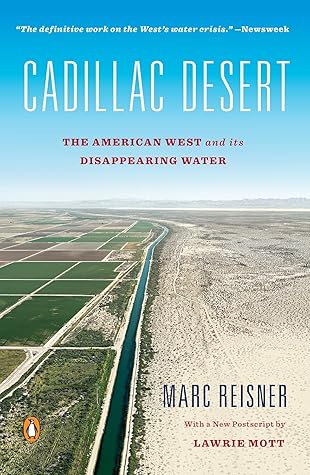More on this book
Community
Kindle Notes & Highlights
by
Marc Reisner
Read between
January 20, 2023 - April 18, 2025
The railroad land grants were a gift the size of California plus the major part of Montana. The deeded lands usually paralleled the railroad’s track; reproduced on maps, they resembled jet streams flowing in reverse. Anyone who bought land from the railroads would be utterly dependent on them for getting his harvests to eastern markets and receiving supplies in return. When the time came to set rates, the railroads could charge pretty much what they pleased. But first they had to seduce the settlers who were still content to battle stumps in Kentucky or endure peonage in Germany and Ireland.
...more
The Indians accepted things as they were; that is why they were mostly nomadic, wandering toward greener grass and fuller herds and flowing water. If whites were going to insist on living there—fixed, settled, mortgaged, fenced—the best they could do with the land was graze it. But in those three states, an economical grazing unit was, say, twenty-five hundred to five thousand acres, depending on the circumstances. To amass that much land you had to cheat—on a magnificent scale. If you didn’t, you had to overgraze the land and ruin it, and many millions of acres were damaged or ruined in
...more
Then there was the Swamplands Act, or Swamp and Overflow Act—a Desert Lands Act of the bulrushes. If there was federal land that overflowed enough so that you could traverse it at times in a flat-bottomed boat, and you promised to reclaim it (which is to say, dike and drain it), it was yours. Henry Miller, a mythical figure in the history of California land fraud, acquired a large part of his 1,090,000-acre empire under this act. According to legend, he bought himself a boat, hired some witnesses, and put the boat and witnesses over county-size tracts near the San Joaquin River, where it
...more
“To clear, to till, and to transform the vast uninhabited continent which is his domain, the American requires the daily support of an energetic passion; that passion can only be the love of wealth; the passion for wealth is therefore not reprobated in America, and, provided it does not go beyond the bounds assigned to it for public security, it is held in honor.”
A pseudoscientific dogma, Social Darwinism, had been invented to give predatory behavior a good name. Darwin could not be taught in the schools; but a perversion of Darwin could be practiced in real life.
Henry Adams wrote, “the majority at last declared itself, once and for all, in favor of the capitalistic system with all its necessary machinery . . . the whole mechanical consolidation of force . . . ruthlessly . . . created monopolies capable of controlling the new energies that America adored.”
What is remarkable, a hundred years later, is how little has changed. The disaster that Powell predicted—a catastrophic return to a cycle of drought—did indeed occur, not once but twice: in the late 1800s and again in the 1930s. When that happened, Powell’s ideas—at least his insistence that a federal irrigation program was the only salvation of the arid West—were embraced, tentatively at first, then more passionately, then with a kind of desperate insistence. The result was a half-century rampage of dam-building and irrigation development which, in all probability, went far beyond anything
...more
In 1848, the population of San Francisco was eight hundred; three years later, thirty-five thousand people lived there. In 1853, the population went past fifty thousand and San Francisco became one of the twenty largest cities in the United States. By 1869, San Francisco possessed one of the busiest ports in the world, a huge fishing fleet, and the western terminus of the transcontinental railroad. It teemed with mansions, restaurants, hotels, theaters, and whorehouses. In finance it was the rival of New York, in culture the rival of Boston; in spirit it had no competitor.
“He is a damned cuss who doesn’t seem to feel well unless he is in a row with someone,”
In the West, drought tends to come in cycles of about twenty years, and the next drought arrived on schedule. The years 1919 and 1920 were a premonition; rainfall was slightly below average. It rose back to average—a measly fourteen inches—in 1921 and went slightly over that in 1922. Then it crashed. Ten inches in 1923; six inches in 1924; seven inches in 1925. In Florida, a seven-inch rainstorm may occur two or three times a year, but Los Angeles was trying to look like Florida, and grow even faster, on a fifth of its precipitation, and when the drought struck it kept going on a tenth.
...more


